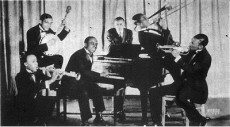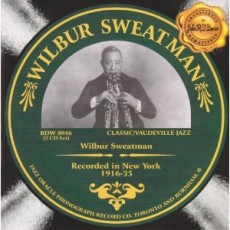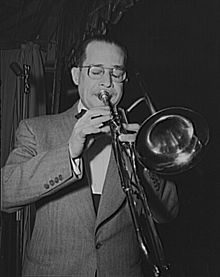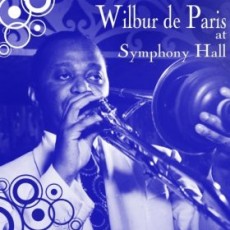
Daily Dose OF Jazz…
Algeria Junius “June” Clark was born on March 24, 1900 in Long Branch, New Jersey and played piano as a child. He went on to learn bugle and trumpet, playing in local brass bands. Taking a job as a porter in New Orleans, he played in a musical revue called S. H. Dudley‘s Black Sensations, alongside James P. Johnson.
Clark and Johnson parted from the show to play on their own, landing in Toledo, Ohio and playing with Jimmy Harrison in the late 1910s. By 1920 Clark relocated to Philadelphia performing with Josephine Stevens and Willie “The Lion” Smith. He would go on to work in the traveling show Holiday in Dixie, but after a poor run it folded and Clark temporarily took up work in an automobile factory.
Rejoining Harrison soon after as a member of the Fess Williams Band, by 1924 June was in New York City playing with his own band. In the 30s he played with Ferman Tapp, Jimmy Reynolds, George Baquet, Charlie Skeete and Vance Dixon. However, failing health led him to quit music and he became Louis Armstrong’s tour manager.
Suffering from an extended bout of tuberculosis in 1939 Clark was bedridden for several years. After his recovery he worked as a musical advisor and assisted Earl Hines. Giving up music altogether, in the Forties he turned to boxing and became Sugar Ray Robinson’s manager. On February 23, 1963 trumpeter, cornetist, advisor and manager June Clark passed away in New York City.
More Posts: trumpet

Daily Dose Of Jazz…
Wilbur C. Sweatman was born in Brunswick, Missouri on February 7, 1882 and started playing violin but took up clarinet. He toured with circus bands in the late 1890s, briefly played with the bands of W.C. Handy and Mahara’s Minstrels before organizing his own dance band in Minneapolis, Minnesota by late 1902.
It was there that Sweatman made his first recordings on phonograph cylinders in 1903 for a local music store. These included what is reputed to have been the first recorded version of Scott Joplin’s “Maple Leaf Rag”; however, no copies of these are known to exist today. By 1908, Sweatman was in Chicago as bandleader at the Grand Theater where he attracted notice and in a 1910 article was referred to his nickname, “Sensational Swet.”
By 1911, he had moved to the vaudeville circuit full-time, developing a successful act of playing three clarinets at once, went on to write a number of rags including his most famous “Down Home Rag”. He would move back to New York, tour major vaudeville circuits, befriend Scott Joplin and become his executor, record for Emerson Records, and the first Black to make recordings as Jazz or “Jass” as it was known then and one of the first to join ASCAP, and several notable musicians passed through his band, including Duke Ellington, Coleman Hawkins and Cozy Cole.
Wilbur Sweatman, ragtime and Dixieland jazz composer, bandleader and clarinetist who continue to record for Gennett, Edison, Grey Gull and Victor record labels, passed away in New York City on March 9, 1961.
More Posts: clarinet

Daily Dose Of Jazz…
Juan Tizol was born on January 22, 1900 in Vega Baja, Puerto Rico and from an early age music was in his life with his first instrument being the violin, but soon switched to valve trombone, his career choice. His uncle Manuel Tizol, music director of the San Juan symphony taught his mostly throughout his youth. He played in his uncle’s band and also gained experience by playing in local operas, ballets and dance bands.
By 1920, Juan joined a band that was traveling to the U.S. to work in Washington D.C. The group eventually made it to Washington, traveling as stowaways, and established residence at the Howard Theater where they played for touring shows and silent movies. At the Howard they also were hired to play in small jazz or dance groups. This is where Juan first came in contact with Duke Ellington.
Tizol got the call to join the Ellington band in the summer of 1929 and became the fifth voice in the brass section of Ellington’s orchestra. This opened up new possibilities for Duke’s writing, as he now could write for trombones as a section instead of just having them play with the trumpets. Juan’s rich, warm tone also blended nicely with the saxophone section, so he was often scored carrying the lead melody with the saxophones.
Juan made many contributions to the Ellington band throughout the 1930s and 40s. One of his major roles in the band was copying parts from Ellington’s scores. Besides copying, Juan also was a band composer. His best-known compositions, Caravan and Perdido are still played by jazz musicians today. Tizol was responsible for bringing Latin influences into the Ellington band with compositions such as Moonlight Fiesta, Jubilesta, Conga Brava, and others.
Juan left Ellington’s band in 1944 to play in the Harry James Orchestra in Los Angeles, to spend more time with his wife. He returned to Ellington in ‘51, but returned to James two years later and remained predominantly on the West Coast for the remainder of his career, playing sporadically with Harry James, Nelson Riddle, and on the Nat King Cole television show.
After another short stint with Ellington in the ‘60s, trombonist Juan Tizol eventually retired in Los Angeles and passed away on April 23, 1984 in Inglewood, California.
More Posts: trombone

Daily Dose Of Jazz…
Wilbur de Paris was born on January 11, 1900 in Crawfordsville, Indiana to a father who played trombone, banjo and guitar. By the autumn of 1906, when he was five, de Paris had started playing alto saxophone, and a year later was working for his father in one of his plantation shows that mainly worked the TOBA circuit in the South.
De Paris heard jazz first at age 16, as a member of a summer show that played at the Lyric Theatre. He met Louis Armstrong whilst playing the saxophone at Tom Anderson’s Cafe with A. J. Piron. After high school, de Paris worked for his father for a time, then worked for more travelling shows in the east. He followed this period with a move to Philadelphia in the early Twenties and started his first band – Wilbur de Paris and his Cottonpickers.
Post Wall Street Crash in 1929, Wilbur disbanded his second group and went to New York, playing and recording for many years with the jazz greats.In the late 1940s, together with his brother, Sidney, he started a band called New New Orleans Jazz, featuring legendary jazzmen including Jelly Roll Morton, Zutty Singleton and Omer Simeon. This band became an institution in New York City during the 1950s, recorded extensively and toured the world.
Trombonist and bandleader Wilbur de Paris, known for mixing New Orleans jazz with swing, passed away on January 3, 1973, eight days shy of his 73rd birthday.
More Posts: trombone




